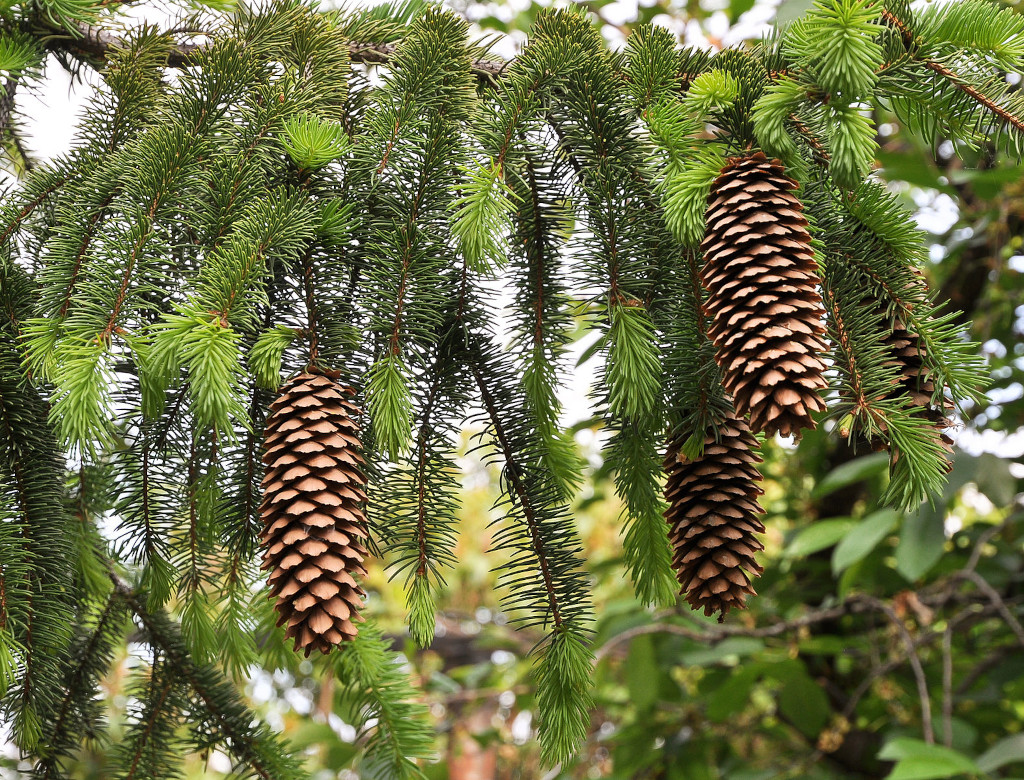
Norway
Norwegian Spruce “Gram”
Picea abies

General Description/Cultural Significance
Norway makes up the western half of the Scandinavian peninsula and contains an imposing terrain including glacial fjords, mountains, and over 50,000 islands. Although nearly half of Norway’s population lives in the milder climate of the southern region of the country, near the capital Oslo, there is a deep cultural respect for the grand nature throughout the country which is encapsulated in the traditional Norwegian motto, friluftsliv, meaning “free air life.” The Norwegian Spruce “Gram,” is a symbol for this adoration of nature and is brought inside most Norwegian homes as the annual Christmas tree. In a region where winter days may last only a few hours and the temperatures can be bitterly cold, breathing in the scent of a spruce tree in one’s own home can bring respite from seasonal depression and solidify the cultural connection to nature provided by the natural aromatherapy of the tree’s resin.
The Norwegian Spruce “Gram” is internationally recognized as the scent of Christmas and the friluftsliv concept of bringing nature into the home through the Christmas tree became a cultural practice all over the world. However, the tree is not simply symbolic, it also has very practical benefits that date back to ancient times. Norwegian Vikings used to brew Spruce Beer from the plant believing that it would prevent scurvy, help with fertility issues, and prepare them for battle. Although it may not be the best modern treatment for scurvy, research has shown that drinks using the twigs and needles from the Norwegian Spruce “Gram” have antiscorbutic and diuretic properties and that resin from the plant is an effective treatment for skin ulcers and infected wounds.
Climate Change/Conservation Status
Norway’s location in the Arctic makes it particularly sensitive to climate change and increase in global temperatures. However, it is not simply rising temperature or melting ice which threatens Norway’s ecosystems. One of the most dire impacts of climate change for this northern country is the increase in forest fires. Although small forest fires are healthy and increase biodiversity, larger fires can be extremely dangerous to animal life, humans, and the survival of forests containing Norwegian Spruce trees.
In addition to forest fires, Norway faces increased rainfalls and flooding, stronger storms (which can topple trees), rising sea levels, ocean acidification, summer droughts, and increased presence of insects which are parasitic to Norwegian Spruce trees. Climate change can cause ripple effects in food chains and ecosystems, creating a higher presence of certain insects when their predators are harmed by habitat loss or other environmental impacts. For example, in Norway there have been higher levels of spruce bark beetles which can be devastating to spruce forests and the peppered moth, Biston betularia, which is particularly dangerous for birch trees. Climate change is not only causing outright damage to the Norwegian Spruce population, it is also changing the course of its life cycle. The rising springtime temperatures have caused Norwegian Spruce trees to flower 4-8 days earlier than normal (May 17-30 instead of May 21-early June) and to shorten their phenophase by about 4 days. Although most people may picture endangered animals such as the polar bear or puffin when they think of the impacts of climate change on the Arctic, according to Norway’s Red List for species there are 2,355 threatened species in the country, most of which are plants, moss or lichen. The survival of majestic animals such as polar bears and penguins relies upon these threatened plant species which are the foundation of the northern ecosystem.
Young Norwegians are aware of this threat and its devastating consequences to their futures, and they are taking the case to the European Court of Human Rights. In June of 2021, six young environmental activists filed a formal complaint with the European Court of Human Rights claiming that the Norwegian government’s decision to extract oil from the Barents Sea (a fragile northern area) was a direct violation of their individual human rights by increasing the “disproportionate risk of harm faced by the applicants due to climate change.” Hopefully the persistent friluftsliv attitude in these young Norwegians is enough to protect the cultural heritage of the spruce tree and its highly symbolic scent.
Uniquely placed in Norway’s Arctic circle on Spitsbergen, part of Norway’s Svalbard archipelago, is the global seed vault, also known as the Doomsday Vault, that holds crop seeds from around the world as a backup for apocalyptic events. Strategically placed deep in the permafrost, the vault chambers began to leak a few years back due to unusually heavy rains and melting permafrost. The breach is now repaired but not forgotten. Redundant seed banks around the world must be created to secure both the world’s crop seeds and plant diversity.
Alternate Names
Norway Spruce
Sources
Bazilchuk, N. (2018). Here’s What a Warmer World Will Look Like in Norway. ScienceNorway.no.
Christensen, J. (2019). Norway | Facts, Points of Interest, Geography, & History. In: Encyclopædia Britannica. [online] Available at: https://www.britannica.com/place/Norway.
Climate Change Knowledge Portal. (2021). Norway. [online] Available at: https://climateknowledgeportal.worldbank.org/country/norway#:~:text=Norway%20is%20vulnerable%20to%20the,level%20rise%2C%20and%20ocean%20acidification.
Greenpeace International. (2022). Young Norwegian environmentalists ask the European Court of Human Rights to secure their rights in the face of climate change. [online]
Schlyter, P., Stjernquist, I., Bärring, L., Jönsson, A.M. and Nilsson, C. (2006). Assessment of the Impacts of Climate Change and Weather Extremes on Boreal Forests in Northern Europe, Focusing on Norway Spruce. Inter-Research Science Publisher, 31(1).
Škvareninová, J. and Mrekaj, I. (2022). Impact of Climate Change on Norway Spruce Flowering in the Southern Part of the Western Carpathians. Fronteirsin.org.

